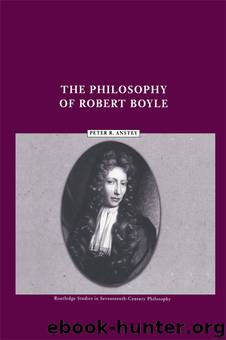The Philosophy of Robert Boyle by Anstey Peter R.;

Author:Anstey, Peter R.;
Language: eng
Format: epub
ISBN: 178665
Publisher: Taylor & Francis Group
Part II
Matter in motion
5 Natural and violent states and motions
Having set out Boyle’s theory of the qualities of bodies, we are now in a position to embark on an exposition of how the various components of his corpuscular hypothesis fit together. We are now well placed to map out the nature and scope of Boyle’s mechanism. In order to do so we will first examine Boyle’s understanding of the nature of motion with particular reference to his rejection of the scholastic distinction between natural and violent states. We will then turn to his conceptions of space, laws of nature and finally to the issue of mind/body interaction.
An examination of these issues will enable us to determine the extent to which Boyle broke from scholastic physics and embraced and championed the mechanical philosophy. It will also enable us to see that Boyle’s mechanism was not simply created in the image of Descartes’ but had its own distinctive stamp and idiosyncrasies. For example, our discussion of his views on the nature of place and laws reveals that Boyle’s cosmology was decidedly non-Cartesian and that the self-styled Christian virtuoso developed a unique account of the relation of God to the created order. This is an account that invokes a peculiar conception of laws of nature and one that is particularly sensitive to the theological problems that beset the mechanical philosophy.
Our immediate concern however is with Boyle’s understanding of the concept of motion. And here, surprisingly, we encounter an issue of some interest to historians of science. For Boyle stands in a transitional phase in the emergence of a clear conception of motion, in particular a clear concept of inertial motion. Much ground had been made by Galileo and Descartes, but in a number of areas scholastic conceptions still muddied the waters in the mid-seventeenth century. The distinction between natural and violent motions still held sway in many quarters and a related distinction between natural and violent states was widely held. Both of these distinctions would have to be completely expunged before a clear conception of inertial motion could emerge. Indicative of this transitional phase is the fact that writers like Hobbes, Wallis and even Boyle often articulate laws of nature that seem at first sight to be approximations of, or precursors to, Newton’s first law. For example in the Boyle Papers, when discussing problems with the Epicurean concept of motion, Boyle speaks of
one of the most fundamentall Customes or Laws of nature, which is that every undivided Body will alwayes continue in that state wherein it is, unless it be put out of it by some Externall force…
(BP, vol. 2, fol. 6)
When pressed, however, it is clear that inertial motion is not in the minds of these writers at all. What we do find in Boyle, is a concerted attack on the notions of natural and violent motions and natural and violent states. And although there is no evidence that this had any influence on the young Newton, what is does show is
Download
This site does not store any files on its server. We only index and link to content provided by other sites. Please contact the content providers to delete copyright contents if any and email us, we'll remove relevant links or contents immediately.
The remains of the day by Kazuo Ishiguro(7539)
Tools of Titans by Timothy Ferriss(6933)
The Black Swan by Nassim Nicholas Taleb(6181)
Inner Engineering: A Yogi's Guide to Joy by Sadhguru(5886)
Giovanni's Room by James Baldwin(5868)
The Way of Zen by Alan W. Watts(5786)
The Six Wives Of Henry VIII (WOMEN IN HISTORY) by Fraser Antonia(4784)
The Power of Now: A Guide to Spiritual Enlightenment by Eckhart Tolle(4747)
Astrophysics for People in a Hurry by Neil DeGrasse Tyson(4613)
Asking the Right Questions: A Guide to Critical Thinking by M. Neil Browne & Stuart M. Keeley(4559)
12 Rules for Life by Jordan B. Peterson(3722)
The Ethical Slut by Janet W. Hardy(3494)
Skin in the Game by Nassim Nicholas Taleb(3454)
Housekeeping by Marilynne Robinson(3394)
The Art of Happiness by The Dalai Lama(3376)
Double Down (Diary of a Wimpy Kid Book 11) by Jeff Kinney(3266)
Skin in the Game: Hidden Asymmetries in Daily Life by Nassim Nicholas Taleb(3259)
Walking by Henry David Thoreau(3227)
12 Rules for Life: An Antidote to Chaos by Jordan B. Peterson(3195)
